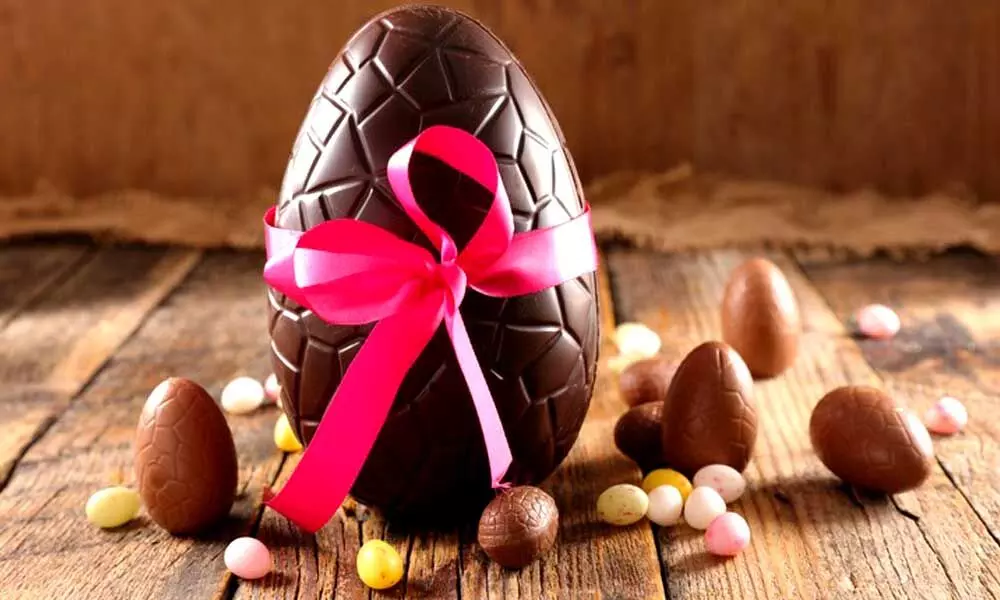How Easter eggs adding value to chocolate industry?
Premium chocolate containing a higher proportion of cocoa beans is becoming increasingly popular among shoppers
image for illustrative purpose

In India, ITC's Fabelle Exquisite Chocolates, acclaimed for re-imagining festive and celebratory offerings into inimitable chocolate experiences has launched its limited edition, signature Fabelle Easter Egg and Fabelle Mini Eggs
EASTER eggs, also called Paschal eggs are eggs that are sometimes decorated. They are usually used as gifts on the occasion of Easter. The egg, an ancient symbol of new life, has been associated with pagan festivals celebrating spring. From a Christian perspective, Easter eggs are said to represent Jesus' emergence from the tomb and resurrection. first official White House egg roll occurred in 1878, when Rutherford B Hayes was president.
The largest Easter egg ever made was over 25 feet high and weighed over 8,000 pounds. It was built out of chocolate and marshmallow and supported by an internal steel frame.
With an estimated value of around £20 million, the ornamental third imperial is widely regarded as the most expensive Easter egg of all time. Made by Peter Carl Fabergé for Russian tsar Alexander III, he presented it as an Easter gift in 1887 to his wife, Maria Feodorovna. Its elaborately designed exterior comprises an 18-carat gold 'shell' and tripod, coloured gold alloys, diamonds and sapphires. Inside is a 14-carat gold timepiece from luxury watchmaker Vacheron Constantin.
Decorating eggs for Easter is a tradition that dates back to at least the 13th century, according to some sources. One explanation for this custom is that eggs were formerly a forbidden food during the Lenten season, so people would paint and decorate them to mark the end of the period of penance and fasting, and then eat them on Easter as a celebration.
For almost a century after the first ones were produced in the 1870s by Fry's and Cadbury's, chocolate eggs were a luxury product. They were expensive, and difficult to find, with specialist confectioners often requiring orders to be made several months in advance.
The ease of buying an Easter egg changed dramatically for British consumers in the middle of the 20th century, as they appeared in a wider range of retail outlets, just a few years after the end of wartime rationing.
Chocolate eggs first appeared at the court of Louis XIV in Versailles and in 1725 the widow Giambone in Turin started producing chocolate eggs by filling empty chicken egg shells with molten chocolate In 1873 JS Fry & Sons of England introduced the first chocolate Easter egg in Britain. Manufacturing their first Easter egg in 1875, Cadbury created the modern chocolate Easter egg after developing a pure cocoa butter that could be moulded into smooth shapes.
Easter eggs are traditionally made using chocolate, marzipan and marshmallow. In the Indian state of Goa, the Goan Catholic version of marzipan is used to make Easter eggs. In the Philippines, mazapán de pili (Spanish for "pili marzipan") is made from pili nuts.
"Premium chocolate containing a higher proportion of cocoa beans is becoming increasingly popular among shoppers," says Rabobank, analyst, Andrew Rawlings.
Demand for darker chocolate is being driven by its vegan credentials, presumed health benefits, lower sugar content than milk chocolate, ability to take on exotic and unusual ingredients, and older shoppers' taste for more bitter flavours.
In fact, dark is "one of the biggest growing trends" in chocolate, according to Susan Nash, trade communications manager at Mondelez.
In India, ITC's Fabelle Exquisite Chocolates, acclaimed for re-imagining festive and celebratory offerings into inimitable chocolate experiences has launched its limited edition, signature Fabelle Easter Egg and Fabelle Mini Eggs.
The global chocolate market reached a value of almost $106.6 billionn in the year 2020. The industry is further expected to grow at a CAGR of 5.5 per cent between 2021 and 2026 to reach a value of almost $147 billion by 2026.
APAC is a strong growth market for chocolate confectionery globally. According to Euromonitor, the segment is forecast to increase in category value with volume growth (1.6 per cent CAGR), and impressive value growth (4.1 per cent CAGR) in the next 5 years from 2020 to 2025.
It is the market for chocolate confectionery, after Europe and North America at over $15 billion in retail sales. As a less mature market, exciting and progressive innovation has a big impact that can influence international flavor trends and spark inspiration for chocolate makers around the world
According to IMARC Group's latest report, titled "India Chocolate Market: Industry Trends, Share, Size, Growth, Opportunity and Forecast 2021-2026", the Indian chocolate market reached a value of $1.9 billion in 2020.

